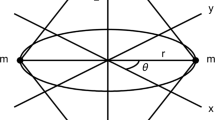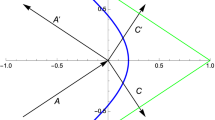Abstract
It is shown that, in the neighborhood of a collision singularity, the motion in a perturbed two-body problem\(\ddot r = - \mu r^{ - 3} r + P\), whereP remains bounded, has the same basic properties as the motion in the neighborhood of a collision in the unperturbed two-body problemP=0.
Similar content being viewed by others
Abbreviations
- ab :
-
scalar product of vectorsa andb; alsoaa=a 2=a 2
- a×b :
-
vector product
- |a|=a :
-
absolute value
- \(v = \dot r\) :
-
velocity
- c,c,c k ,c k :
-
are constants andb,b,b k ,b k functions, bounded for the arguments under consideration; without subscript they may change their value from one occurrence to the next, while with subscripts they have specific values.
- c 2k :
-
denotes correspondingly a positive (or nonnegative) constant
References
Arenstorf, R. F.: 1969, ‘Regularization Theory for the Elliptic Restricted Three-Body Problem’ (to be published inJ. Differential Equations).
Sperling, H. J.: 1968, ‘The Binary Collision in theN-Body Problems’,Icarus 9, 305–314.
Sperling, H. J.: 1969, ‘On the Real Singularities of theN-Body Problem’ (to be published inJ. Reine Angew. Math).
Author information
Authors and Affiliations
Rights and permissions
About this article
Cite this article
Sperling, H.J. The collision singularity in a perturbed two-body problem. Celestial Mechanics 1, 213–221 (1969). https://doi.org/10.1007/BF01228841
Received:
Issue Date:
DOI: https://doi.org/10.1007/BF01228841




